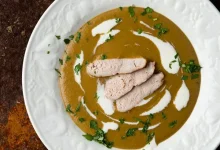🥖🇨🇴 Pan de Bono: A Taste of Colombian Culture 🇨🇴🥖
Pan de Bono, or “good bread” in English, is a delicious and iconic Colombian baked treat. This unique delicacy is a blend of tradition, flavor, and history, and it’s an absolute must-try if you’re exploring Colombian cuisine. 🇨🇴❤️
History:
Pan de Bono has a long and rich history, dating back to Colombia’s colonial era when Spanish influences mixed with indigenous flavors. The exact origin is a bit unclear, but it’s believed to have originated in the Andean region of Colombia. Over the years, Pan de Bono has become a beloved and cherished part of Colombian culture and cuisine, often enjoyed at breakfast, as a snack, or with a cup of hot chocolate.
Components:
This delightful bread is made from a combination of simple but flavorful ingredients:
-
Cassava (Yuca) Starch: The primary ingredient is cassava starch, which gives the bread its distinct chewy and slightly dense texture.
-
Cheese: Cheese, usually queso fresco or queso costeño, is another essential component that provides a delightful savory note.
-
Starches: Cornstarch and tapioca starch are often added to enhance the texture and binding of the dough.
-
Eggs: Eggs contribute to the dough’s moisture and provide structure.
-
Baking Powder: Baking powder is used as a leavening agent, giving the bread a slight rise and a tender crumb.
-
Salt and Sugar: These add flavor and balance to the bread.
Steps to Prepare Pan de Bono:
Now, let’s dive into the steps to prepare this tasty Colombian treat:
-
Preheat Your Oven: Begin by preheating your oven to 350°F (180°C).
-
Mix the Dry Ingredients: In a mixing bowl, combine the cassava starch, cornstarch, tapioca starch, baking powder, sugar, and a pinch of salt.
-
Add the Wet Ingredients: Add eggs and crumbled cheese to the dry mixture. Knead the dough until it becomes homogeneous.
-
Shape the Dough: Take small portions of the dough and shape them into small round balls, about the size of a ping pong ball.
-
Bake: Place the dough balls on a baking sheet lined with parchment paper and bake for about 15-20 minutes, or until they’re golden and slightly puffed.
-
Serve: Pan de Bono is best served warm, straight out of the oven. They can be enjoyed on their own, with a cup of hot chocolate, or as a side dish to many Colombian meals.
Time Needed:
The preparation of Pan de Bono is relatively quick and easy. It takes approximately 30-40 minutes from start to finish, making it a great choice for a delicious snack or side dish.
So, whether you’re exploring Colombian cuisine, looking for a unique and flavorful bread, or simply curious to try something new, Pan de Bono is a delightful option that combines tradition and taste. Enjoy! 🇨🇴🥖😋
Certainly! Here are the nutrition facts and some health information for Pan de Bono:
Nutrition Facts (Per Serving, Approx. 1 Pan de Bono):
- Calories: Approximately 120-150 calories
- Carbohydrates: About 15-20 grams
- Protein: Around 3-5 grams
- Fat: Roughly 5-7 grams
- Dietary Fiber: Less than 1 gram
- Sugars: Around 2-3 grams
- Sodium: Approximately 100-200 milligrams
Health Information:
-
Moderate Calories: A single Pan de Bono contains a moderate amount of calories, making it a reasonable choice for a snack or part of a meal.
-
Carbohydrates: The primary source of calories in Pan de Bono is carbohydrates. It provides quick energy, but it’s essential to consume in moderation if you’re watching your carb intake.
-
Protein: Pan de Bono contains a small amount of protein, which is essential for various bodily functions, including tissue repair and muscle maintenance.
-
Fat: It contains a modest amount of fat, which adds to its flavor and texture. The type of fat may vary based on the cheese used.
-
Dietary Fiber: Pan de Bono is not a significant source of dietary fiber, so if you’re aiming to increase your fiber intake, you might want to pair it with fiber-rich foods.
-
Sugars: It contains a small amount of sugar, mostly from the sugar used in the recipe. This adds a touch of sweetness to the bread.
-
Sodium: The sodium content can vary depending on the recipe and the type of cheese used. Be mindful of your sodium intake, especially if you have dietary restrictions.
While Pan de Bono is a delightful treat, it’s essential to enjoy it in moderation, especially if you’re following a specific dietary plan. As with any food, it’s best when part of a balanced diet. Enjoying it occasionally can be a delicious way to savor Colombian cuisine. 🥖🇨🇴😋



